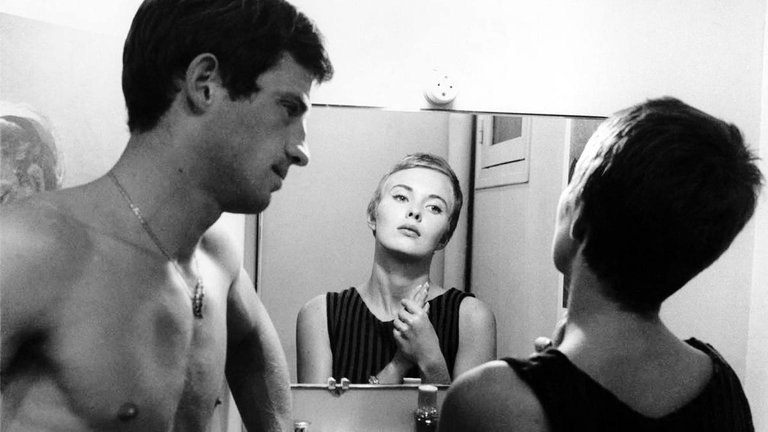Film Review: Breathless (À bout de souffle, 1960)

Many groundbreaking films in the history of cinema have struggled to connect with today's viewers, even when they appear strikingly modern and "hip" for films made long ago. Sometimes, this occurs precisely because of their influence, as by establishing certain standards or tropes, they may not seem particularly special to younger cinephiles who take that content or style for granted. This fate might befall even the grandest of cinema classics, such as Breathless, the 1960 feature-length directorial debut of Jean-Luc Godard, arguably the most celebrated and influential film of the French New Wave.
Despite being hailed as groundbreaking, Breathless is, at least in terms of plot, a surprisingly conventional film. Godard based his script on a story developed by his friends, fellow critics, and New Wave founders François Truffaut and Claude Chabrol. In fact, it was inspired by real events that occurred in 1952 – the highly publicized affair of Michel Portail, a young criminal who murdered a traffic policeman and was later caught and sentenced to life imprisonment.
Portail's fictional alter ego, played by Jean-Paul Belmondo, is Michel Poiccard, a young small-time criminal who fancies himself a "cool" gangster and idolises Humphrey Bogart. One day, he steals a car at the South of France and travels to Paris, where he intends to reunite with his girlfriends, which include Patricia Franchini (played by Jean Seberg), an American university student and aspiring journalist. Along the way, he gets stopped by a traffic policeman and, in a moment of impulse, kills him. After arriving in Paris, he hides in Patricia's apartment and tries to collect debts from old friends with the vague idea of starting a new life in Italy. As the police close in, Patricia begins to wonder whether to remain loyal to her boyfriend.
Breathless is among the most analysed films in the history of cinema, with countless critics, film historians, and scholars trying to find new interpretations and reasons for its importance. Most of these discussions revolve around the change of generations among French filmmakers, with Godard and his friends feeling the need to break with tradition and deliver something new to the screen in the wake of World War II.
Godard, however, took inspiration from the forces that were beginning to dominate the world in those times – America and, especially, Hollywood. Breathless borrowed various tropes and archetypal characters from American film noir, but Godard gave this plot an original treatment.
The most obvious departure from the original film noir formula is the use of a quasi-documentary style. Godard shot many scenes on Parisian streets with what appears to be a handheld camera. Another departure is the upbeat, "hip," and very likeable jazz soundtrack by Martial Solal. Finally, Godard used plenty of jump cuts and various other tricks to remind the audience that they are watching not only fiction, but a true art film. This all culminates in a melodramatic yet somewhat confusing ending that could disappoint ordinary audiences.
On the other hand, while undoubtedly belonging to the world of art cinema, Breathless is also accessible to a general audience. This is due to its quick pace and easily digestible running time of an hour and a half. The excellent black-and-white cinematography by Raoul Coutard makes the whole film appealing. Jean-Paul Belmondo, in the early stages of his stardom, plays the young, brash, and irreverent criminal with great ease. Similarly, American actress Jean Seberg provides a combination of charm, irreverence, and nihilism that would ultimately become the most iconic role of her career. The generally irreverent tone, especially in the description of police detectives pursuing Michel, makes Breathless look almost like a black comedy.
Breathless was immediately hailed by critics as masterpiece and won some important awards, including the Silver Bear for Best Director at the Berlin Film Festival, which turned Godard into one of the most celebrated European film directors of his time. Breathless later became the most iconic of all New Wave films, earned high spots in prestigious critics' polls of the best films ever made, and influenced countless other films in the decades to come, including the seminal 1967 New Hollywood film Bonnie & Clyde.
In 1983, American director Jim McBride paid homage to Breathless with an eponymous remake starring Richard Gere and Valerie Kaprisky. Despite the passage of time and the influence of Breathless on the cinematic landscape, the original remains a testament to the power of cinema as a medium and a celebration of the creative spirit that continues to inspire filmmakers to this day.
RATING: 7/10 (+++)
Blog in Croatian https://draxblog.com
Blog in English https://draxreview.wordpress.com/
InLeo blog https://inleo.io/@drax.leo
Hiveonboard: https://hiveonboard.com?ref=drax
Rising Star game: https://www.risingstargame.com?referrer=drax
1Inch: https://1inch.exchange/#/r/0x83823d8CCB74F828148258BB4457642124b1328e
BTC donations: 1EWxiMiP6iiG9rger3NuUSd6HByaxQWafG
ETH donations: 0xB305F144323b99e6f8b1d66f5D7DE78B498C32A7
BCH donations: qpvxw0jax79lhmvlgcldkzpqanf03r9cjv8y6gtmk9
Posted Using InLeo Alpha
Congratulations @drax! You have completed the following achievement on the Hive blockchain And have been rewarded with New badge(s)
Your next target is to reach 4600 posts.
You can view your badges on your board and compare yourself to others in the Ranking
If you no longer want to receive notifications, reply to this comment with the word
STOPCheck out our last posts: